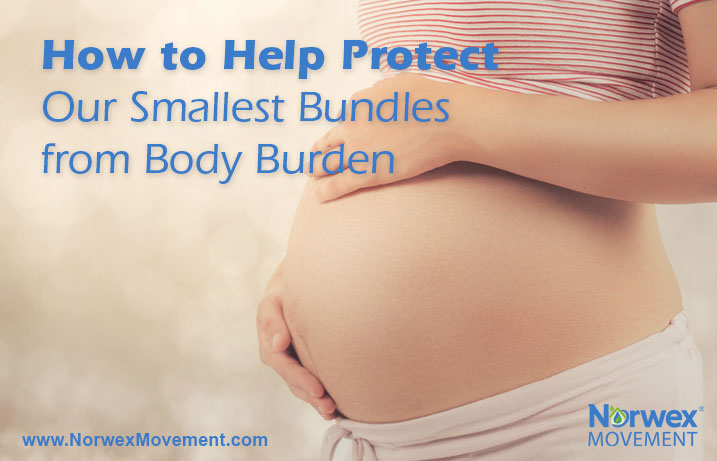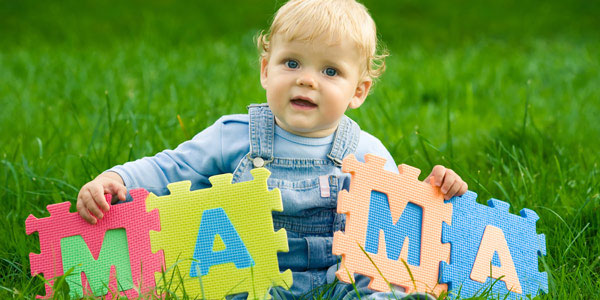

It was a small study, but scary nevertheless: In a 2004 study by the Environmental Working Group, more than 200 industrial compounds, pollutants and other chemicals were discovered in the umbilical cord blood of the 10 U.S. newborns studied. How did these chemicals get there? They could only have been passed along from the mothers.
Scientists call the accumulation of toxins in our bodies a person’s “body burden.” And unfortunately, this study indicates that our children may already be burdened with toxic chemicals before they’ve even officially made their entrance into the world.
Watch this video I made describing how chemicals can build up over time and be passed along from mother to baby.
Even more concerning news came from a follow-up study conducted in 2009. While the 2004 study didn’t test for certain chemicals like BPA, which wasn’t as widely used then, the 2009 study did reveal BPA in nine of the ten cord blood samples tested. Other new toxins were also revealed, including tetrabromobisphenol A (TBBPA), the world’s most heavily manufactured brominated fire retardant (BFR) and routinely used in electronic circuit boards; as well as synthetic fragrances used in common cosmetics and detergents, and perfluorobutanoic acid (PFOA), which is used in the process of making Teflon®.

While different groups of people can be more or less susceptible to the toxic effects of harmful chemicals, children are among the most vulnerable, according to the National Academy of Sciences. Here’s why:
What effects can the buildup of harmful chemicals have on our children? Scientists have linked such health problems as asthma, childhood cancer and neuro-developmental disorders to common contaminants like solvents, pesticides, PCBs and volatile organic compounds.

Avoiding chemical exposure is almost impossible, but there are steps you can take to limit it. Dr. Johanna Congleton from the Environmental Working Group has this advice for reducing flame retardant chemicals in your home.
Dr. Leo Trasande, co-director of Mount Sinai’s Children’s Environmental Health Center, further advises expectant mothers:
In addition, steer clear of toxic household cleaning products as well as personal care products and/or cosmetics containing fragrances or other harmful chemicals. Read labels carefully and always make sure you know what is brought into your home.
We may not be able to protect our babies and children from exposure to harmful chemicals one hundred percent of the time, but by taking reasonable precautions we can significantly limit their contact.
Resources:
SO scary!!! Definitely an eye-opening article!
Switching to safer household products is so important! And it’s just as important to switch to safer personal care products for the whole family! A lot of companies that claim to be safe still contain harmful chemicals, always check your ingredients! Norwex and Beautycounter are my go to brands to keep my family safe <3
Great video Amy. 🙂
We have 3 kids under 6, and after our oldest was diagnosed with asthma and severe allergies as a toddler, we really started taking steps to reduce our exposure to toxins. Changes such as switching away from toxic cleaners & body care products, getting rid of plastics for food storage and switching to glass, and removing candles & air fresheners from our home have made a big difference in our health!
Tanya, thanks for sharing what’s worked for your family. It’s amazing how big a difference simple lifestyle changes really can make!
I purged out all toxic chemicals from our home when I got pregnant. I couldn’t stand the smell. Even walking down the street I could smell the horrible fumes from dryer sheets emanating from peoples’ homes and they made me sick. A pregnant woman’s sense of smell is heightened during pregnancy for the purpose of protecting the baby. That was 25 years ago and Norwex wasn’t around, but I did switch to all natural cleaners and detergents. I love that Norwex has even taken those away…too much clutter! It’s a great thing to bring the affects of these toxic chemicals to light for the sake of our children and grandchildren. Thank you for posting!
As a mom of 2 young babies, these statistics scare me. Unfortunately, I wasn’t aware or educated on all the chemicals we are exposed to when pregnant with my first. But when he was 6 months old, k began my chemical free journey. I feel as though it’s made such a positive impact on our home, and with the information regarding the amount of chemicals found in cord blood, I believe thatour 2nd child had LESS exposure to chemicals while in the womb and I’m proud of that.
Another great video that gets to the point of ‘Why’ Norwex. Thank you for these types of tools to help us get the word out. Always Norwex in my home.
Learning these scary facts when I was pregnant with my first child is the very reason that I switched to greener cleaning! It opened my eyes to how harmful our environment can be, especially for our children!